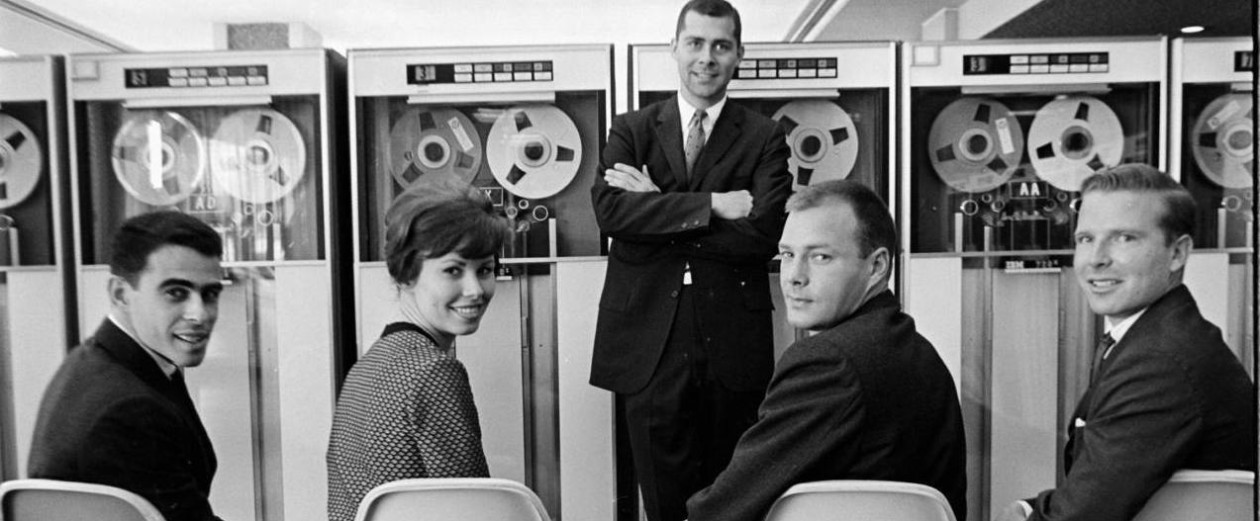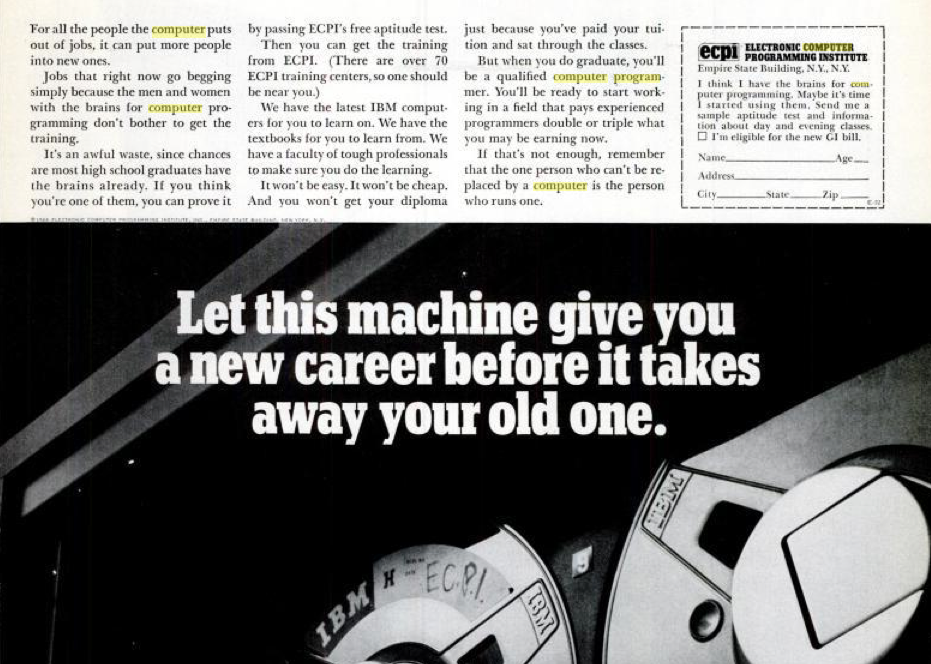In celebration of Black History Month, I have been reflecting on what my scholarship might have to say about the history of African American computer programmers. I have posted previously about race, class, and gender in history of computing, but that was many years ago, and there have been some exciting developments in the literature in the past few years.
When I was writing The Computer Boys, there was almost no literature available on the intersection of race and computing. Nor was there much data to be found in the primary sources.
In their analysis of data the 1970 Census and the Department of Labor’s Area Wage Surveys, Bruce Gilchrist and Richard Weber suggested that out of a total of 161,337 working programmers in the United States, 5,837 (3.6%) were African American. Of male programmers (124,956 total), just 3.2% (4,008) were African American. Of female programmers (36,381 total), slightly more than 5% (1,829) were women.1Bruce Gilchrist and Richard Weber, “Enumerating Full-Time P Communications of the ACM 17, no. 10 (1974): 592–593.
The 1970 Census data also tracked programmer’s of “Spanish heritage”. There were 2,957 male programmers and 602 female programmers in this category.
I have already written about why I think the official numbers underestimate the total number of working programmers. Given the fluidity and limitations of racial categories in Census data in this period, I have similar concerns about this data.
In addition to purely quantitative data, there were indications in my historical sources of not only the contributions of African Americans, but to some interesting questions related to race and computing. For example, in the late 1960s, during a time a particularly visible and violent racial strife, there were several attempts to provide programmer training to black communities. But while some of these were legitimate (and a few were government-sponsored) there were also a number of exploitative vocational schools that preyed on Black communities. In Chapter 3 (“Chess Players, Music Lovers, and Mathematicians”) of the book I write about the larger phenomenon of these schools and their problematic reputation within the industry.
Update: the artist ann haeyoung is developing an oral history project on the IBM Black Workers Alliance that overlaps with the period I cover in book. This is a fascinating project! I had no idea this group existed.
Since The Computer Boys was published, there are a number of histories of Black programmers that have been written. The most prominent of these is Margot Shetterly’s 2016 book Hidden Figures (dramatized in the film, also from 2016), which tells the stories of some of the African American women who worked as “human computers” and programmers in the space program.2Shetterly, Margot Lee. 2016. Hidden Figures: The Untold Story of the African American Women Who Helped Win the Space Race. HarperCollins The film in particular focused on just three of these (Dorothy Vaughan, Mary Jackson, Katherine Johnson), but there were many others: Christine Darden, Annie Easley, Melba Roy Mouton, Jeanette A. Scissum, to name just a few.3See for example Jade Reyerson, “Places of Hidden Figures: Black Women Mathematicians in Aeronautics and the Space Race,” National Park Services. https://www.nps.gov/articles/000/places-of-hidden-figures.htm
One of the earliest scholarly discussions of race and computing in the scholarly literature is Arvid Nelson’s “Race and Computing: The Problem of Sources, the Potential of Prosopography, and the Lesson of Ebony Magazine,” which was published in 2017 in the IEEE Annals of the History of Computing.4Nelsen, R. Arvid. 2017. “Race and Computing: The Problem of Sources, the Potential of Prosopography, and the Lesson of Ebony Magazine.” IEEE Annals of the History of Computing 39 (1): 29–51. I was editor-in-chief of the Annals at that point, and so can say definitively that in the almost four decades that that journal served the journal of record for the history of computing community, that was the first article that explicitly addressed the historiography of race and computing.
More recently, there are a number of scholarly articles and books that deal with questions of race and computing. A few of these are historical, although most deal with more contemporary issues. Here are a few that focus specifically on the African American experience.
Eglash, Ron. 2002. “Race, Sex, and Nerds: From Black Geeks to Asian American Hipsters.” Social Text 2 (20): 49–64.
Browne, Simone. 2015. Dark Matters: On the Surveillance of Blackness.
Shetterly, Margot Lee. 2016. Hidden Figures: The Untold Story of the African American Women Who Helped Win the Space Race. HarperCollins
Williams, Jeannette, Yolande Dickerson, The Invisible Cryptologists: African-Americans, WWII to 1956. United States, National Security Agency/Central Security Service, and Center for Cryptologic History. 2001.
Noble, Safiya Umoja. 2018. Algorithms of Oppression: How Search Engines Reinforce Racism.
Brock, André L. 2019. Distributed Blackness: African American Cybercultures.
Benjamin, Ruha. 2019. Race after Technology: Abolitionist Tools for the New Jim Code. Cambridge: Polity.
McIlwain, Charlton D. 2020. Black Software: The Internet and Racial Justice, from the AfroNet to Black Lives Matter.
Katz, Yarden. 2020. Artificial Whiteness: Politics and Ideology in Artificial Intelligence. Columbia University Press.
Also, since African American inventiveness is not a recent phenomenon, here are a few classics from the history of technology
James, Portia P., and Anacostia Neighborhood Museum. 1990. The Real McCoy: African-American Invention and Innovation, 1619-1930. Washington, D.C.: Published for the Anacostia Museum of the Smithsonian Institution by the Smithsonian Institution Press.
Fouché, Rayvon. 2005. Black Inventors in the Age of Segregation: Granville T. Woods, Lewis H. Latimer, and Shelby J. Davidson. JHU Press.
Sinclair, Bruce, and Massachusetts Institute of Technology. 2004. Technology and the African-American Experience: Needs and Opportunities for Study. Cambridge, Mass.: Massachusetts Institute of Technology.
Green, Venus. 2001. Race on the Line: Gender, Labor, and Technology in the Bell System, 1880-1980. Durham: Duke Univ. Press.
- 1Bruce Gilchrist and Richard Weber, “Enumerating Full-Time P Communications of the ACM 17, no. 10 (1974): 592–593.
- 2Shetterly, Margot Lee. 2016. Hidden Figures: The Untold Story of the African American Women Who Helped Win the Space Race. HarperCollins
- 3See for example Jade Reyerson, “Places of Hidden Figures: Black Women Mathematicians in Aeronautics and the Space Race,” National Park Services. https://www.nps.gov/articles/000/places-of-hidden-figures.htm
- 4Nelsen, R. Arvid. 2017. “Race and Computing: The Problem of Sources, the Potential of Prosopography, and the Lesson of Ebony Magazine.” IEEE Annals of the History of Computing 39 (1): 29–51.

 Follow
Follow